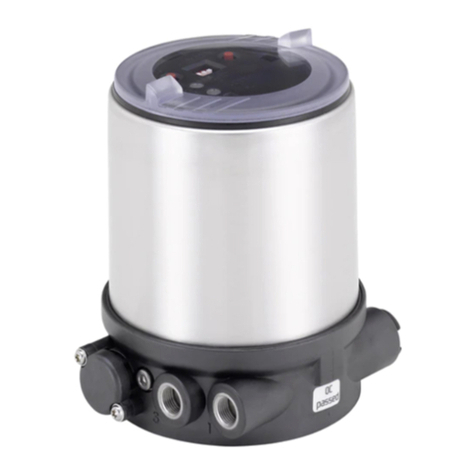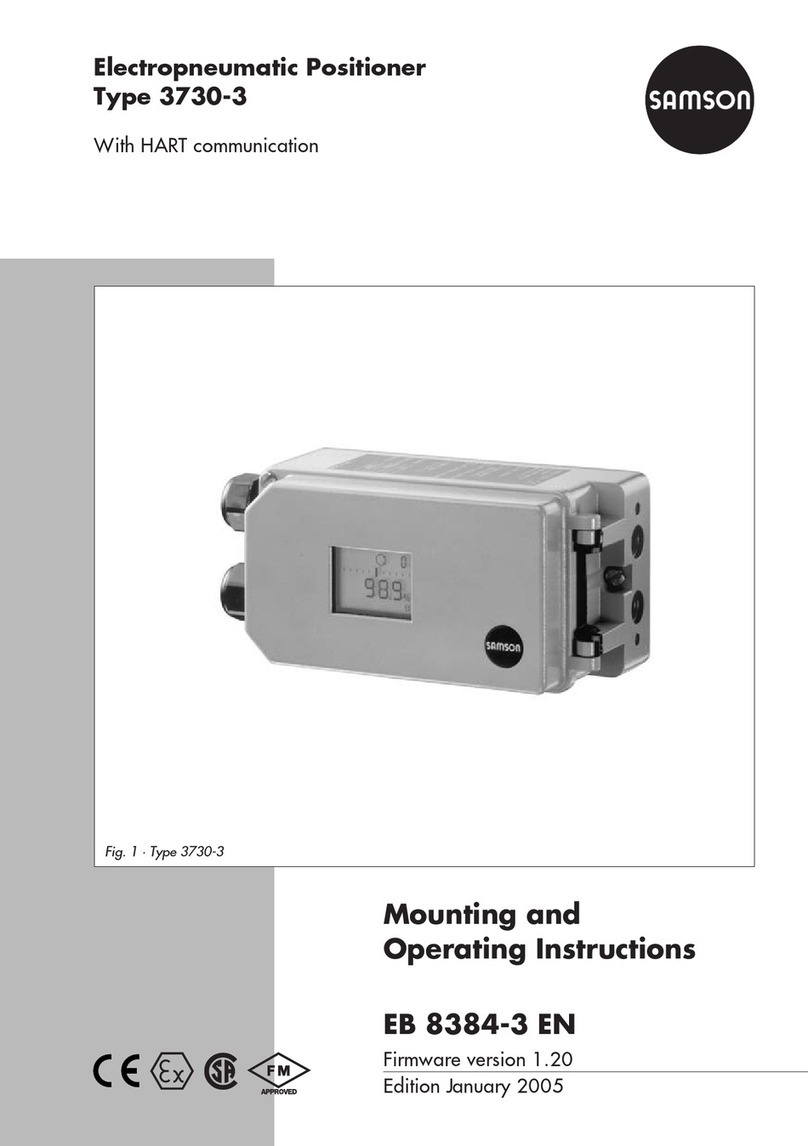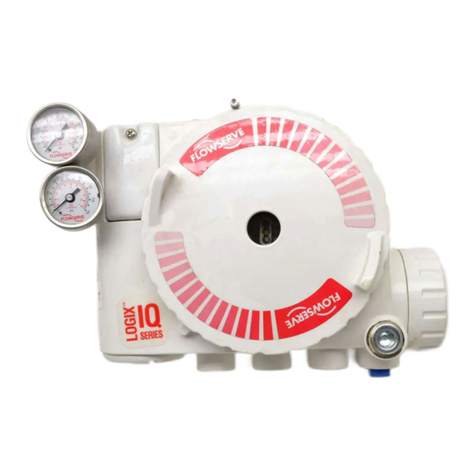
Page 2 of 8 GC31-IOM Rev. B 07/19
SUPPLY PRESSURE (20 to 100 psi / 138 to 690 kPa)
A regulated and filtered air supply should be used. A Conoflow
model FR95 Airpak Filter Regulator or equal is recommended.
ZERO ADJUSTMENT
Zero adjustment can be made by turning the zero adjust
coupling, located on top of the headplate assembly (2), clockwise
or counterclockwise. Connect supply and instrument air to the
positioner. Set the instrument signal to the 0% value (e.g. 3 psi
(21 kPa) for a 3-15 psi (21-143 kPa) range). Turn the zero adjust
coupling to bring the actuator slightly off the fully retracted
position. The starting point may then be checked by reducing the
instrument signal below the 0% value and then slowly increasing
it. As the 0% input signal is reached, extension of the actuator
stem plus an audible increase in the air flow through the
positioner should be observed.
Next, increase the instrument signal to the 100% value (e.g. 15
psi for a 3-15 psi (103 kPa for a 21-103 kPa range). Verify that
the actuator stem moves to the fully extended position.
Set the instrument signal to the 50% value. Using a suitable
measuring device, such as a scale, verify the actuator stem has
extended to 50% of full stroke.
SPAN
Positioner span determines the control range. A positioner with a
3-15 psi (21 to 103 kPa) range has a 12 psi (83 kPa) span and is
set with a 3 psi (21 kPa) start point (retracted position).
Positioner span has been factory calibrated as specified.
Instrument signals of 3-9, 3-15 and 6-30 psi (21-62, 21-103, and
41-207 kPa) are available. For field changes, refer to page 4 of
this manual and Range Spring Manual C-8053.
REMOVING POSITIONER FROM ACTUATOR
WARNING: Shut off supply and instrument
air and assure all pressure is bled before
performing any maintenance.
Piston (or diaphragm) should be in the fully retracted position.
Disconnect tubing and verify all air is bled from the actuator.
Remove cap (1) and Spirolox ring (3) from positioner so the head
plate assembly (2) can be lifted out. Loosen setscrew (24) using
a 1/8” hex key wrench, and remove spring rod nut (16). Remove
the six cap screws (14) and lift positioner from the actuator.
INSTALLING POSITIONER ON ACTUATOR
The Model GC31 positioner is designed for actuators having a 2
¼” dimension between the lower face of the range spring nut
(8D) and the positioner mounting flange with the actuator stem in
a retracted position. See dimensions on Page 5.
The range spring (8C) is adjusted and set at the factory for the
proper range and spring rod (8A) extension, as shown on page 6.
With the actuator stem in the fully retracted position and the
spring rod nut (16) removed from the spring rod (8A), thread the
spring nut assembly (8D) onto the actuator stem. Hold the range
spring assembly in a vertical position without applying any
tension to the range spring (8C). Measure the distance between
the positioner mounting surface on the actuator (without gasket)
and the top of the spring rod (8A). This distance must be 2-5/16”
+/- 1/64” (58.75 +/- 0.41 mm) for proper operation of the
positioner (see page 4). If adjustment is necessary, grasp the
lower spring clip (8B) and range spring (8C) while retightening
the upper clip securely. Measure the 2-5/16” (58.75) dimension
again to make sure it is correct. Be sure the actuator stem is fully
retracted when making this measurement.
Remove the cap (1) from the positioner and, using a small
screwdriver, remove the Spirolox ring (3). Pull out the positioner
headplate assembly (2) and set it aside. The zero spring (4)
should also be attached to the headplate assembly. If not,
remove it also. Place the gasket (13) and the positioner on the
actuator, guiding the spring rod (8A) through the hole in the bell
crank (17). Install the six hex head cap screws (14) that secure
the positioner to the actuator.
Adjust the set screw (24) in the spring rod nut (16) such that the
head of the screw is flush with the top of the nut. Install this
assembly onto the spring rod (8A) finger tight. Hold the spring
rod nut (16) with a wrench to prevent rotation, and tighten the set
screw (24) securely. It is important to make sure that the spring
rod nut (16) does not turn while tightening the set screw in order
to maintain calibration of the range spring assembly.
Insert the zero spring (4) onto the headplate and install the
headplate assembly (2). Make sure the zero spring (4) is
properly centered on the spring rod nut (16) when inserting this
assembly. Replace the Spirolox ring (3). Connect the
necessary piping. Proceed with the zero adjustment procedure
previously outlined. When complete, replace the cap (1).
SYSTEM CONFIGURATIONS
The operation of the Commandaire GC31 positioner with an
actuator may be configured differently, depending on the needs
of the system. The following schematics illustrate several
common configurations for the model GC31 with a piston
actuator.
DOUBLE ACTING ACTUATOR WITH CUSHION LOAD
The use of a suitable cushion load regulator, such as the
Conoflow GH04, will drive double acting actuator operation.
Actuator
CG31 Positioner Instrument Signal
(manual or transducer)
Air Supply
Filter Regulator
P
GH04 Cushion
Load Regulator

























